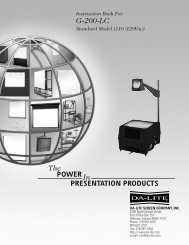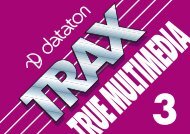Dataton WATCHOUT User's Guide
Dataton WATCHOUT User's Guide
Dataton WATCHOUT User's Guide
Create successful ePaper yourself
Turn your PDF publications into a flip-book with our unique Google optimized e-Paper software.
Computer Generated Material<br />
When using computer-generated moving images, you must specify the frame<br />
rate and resolution of the resulting movie during rendering. Generally, when<br />
combining computer generated and live video material, the frame rate is<br />
dictated by the live material.<br />
In terms of resolution and frame size, you have two main choices:<br />
• Smaller inserts, less than a single display area in size.<br />
• Large areas, spanning multiple displays<br />
It’s often advantageous to use smaller compute-generated moving images<br />
layered on top of larger still images. By rendering only the parts of an image<br />
that actually move, not only do you lower the burden on the playback machine,<br />
but you also reduce rendering times. Keep in mind that you can make nonsquare<br />
movies, or even holes inside movies, by using transparency options in<br />
supporting applications and codecs.<br />
As computer generated movies are by nature resolution independent, it is also<br />
possible to make movies that are larger than a single display area. Such large<br />
movies must be pre-split in order to be used in <strong>WATCHOUT</strong> (see “Pre-splitting<br />
Large Movies” on page 76).<br />
70 Chapter 6: Media Files




